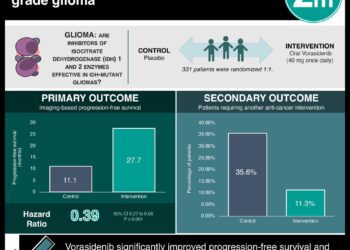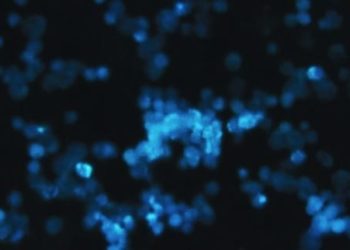Dabrafenib plus trametinib provides clinically important response rates in BRAF-mutated gliomas
1. Response to treatment was noted in 33% of the high-grade glioma cohort and 69% of the low-grade cohort.
2. The most common adverse event in all patients was fatigue.
Evidence Rating Level: 2 (Good)
Study Rundown: Glioblastoma is notably difficult to treat as it is resistant to many therapies. The BRAF inhibitor dabrafenib has been previously shown to have clinical effect in pediatric patients with BRAF mutation-positive glioma. Multiple tumour types have been shown to respond to a dual-combination of dabrafenib and trametinib (a MEK inhibitor). This study explored the outcome on disease response rate, progression-free survival (PFS), overall survival (OS), and safety in adult patients with BRAF mutation-positive high- or low-grade glioma receiving dabrafenib plus trametinib. 33% of patients in the high-grade glioma cohort had an objective response rate, and 69% had a response in the low-grade cohort. In the high-grade glioma cohort, median PFS determined by independent radiology review was 4.5 months, and was 14 months for the low-grade cohort. OS in the high-grade cohort was 17.6 months and was not reached in the low-grade group. The most common adverse event experienced among both groups was fatigue, followed by headache, nausea, and pyrexia. Limitations to this study include the lack of a control group for comparison and a lack of in-depth questionnaire for neurological symptoms. Overall, patients with BRAF mutation-positive high- or low-grade glioma may benefit from treatment with dabrafenib plus trametinib.
Click to read the study in The Lancet Oncology
Click to read an accompanying editorial in The Lancet Oncology
Relevant Reading: BRAF mutation marks out specific subgroups of glioma
In-Depth [randomized controlled trial]: This single-arm, phase 2 study conducted out of multiple centres internationally recruited adult patients with BRAF mutation-positive glioma and separated them into a high-grade cohort (45 patients) or low-grade cohort (13 patients). Patients in the high-grade cohort were required to have measurable disease at baseline in addition to having previously received either radiotherapy, chemotherapy, or both. Those with low-grade glioma were required to have measurable disease at baseline. Objective response rate was the primary outcome, with progression-free survival (PFS), overall survival (OS), and safety being secondary outcomes. An objective response rate was noted in 33% of the high-grade cohort (95% confidence interval (CI), 20-49%). In the low-grade cohort a response rate of 69% was reported (95% CI, 39-91%). Median PFS by independent radiology review was 4.5 months (95% CI, 1.8-7.4 months) in the high-grade cohort, and 14 months (95% CI, 4.7-46.9 months) in the low-grade cohort. OS was 17.6 months (95% CI, 9.5-45.2 months) in the high-grade cohort and not reached in the low-grade cohort (95% CI, 11.6 to not reached). Adverse events were common, with 93% of the total study population experiencing them (47% of the high-grade group, 61% of the low-grade group). 50% of all patients (both cohorts) experienced fatigue, 43% had headache, 34% had nausea, and 33% had pyrexia. Dose reductions were noted in 38% of all patients, interruptions in 41%, and complete termination of treatment in 9% of all patients due to adverse events. Serious adverse events were reported in 33% of the high-grade cohort, the most frequent being seizures. Serious adverse events were found in 23% of the low-grade cohort, the most frequent being pyrexia.
Image: PD
©2021 2 Minute Medicine, Inc. All rights reserved. No works may be reproduced without expressed written consent from 2 Minute Medicine, Inc. Inquire about licensing here. No article should be construed as medical advice and is not intended as such by the authors or by 2 Minute Medicine, Inc.


![Addition of bevacizumab fails to benefit overall survival in newly diagnosed glioblastoma [RTOG 0825 trial]](https://www.2minutemedicine.com/wp-content/uploads/2014/02/AFIP-00405558-Glioblastoma-Radiology-e1381685577283-350x250.jpg)




